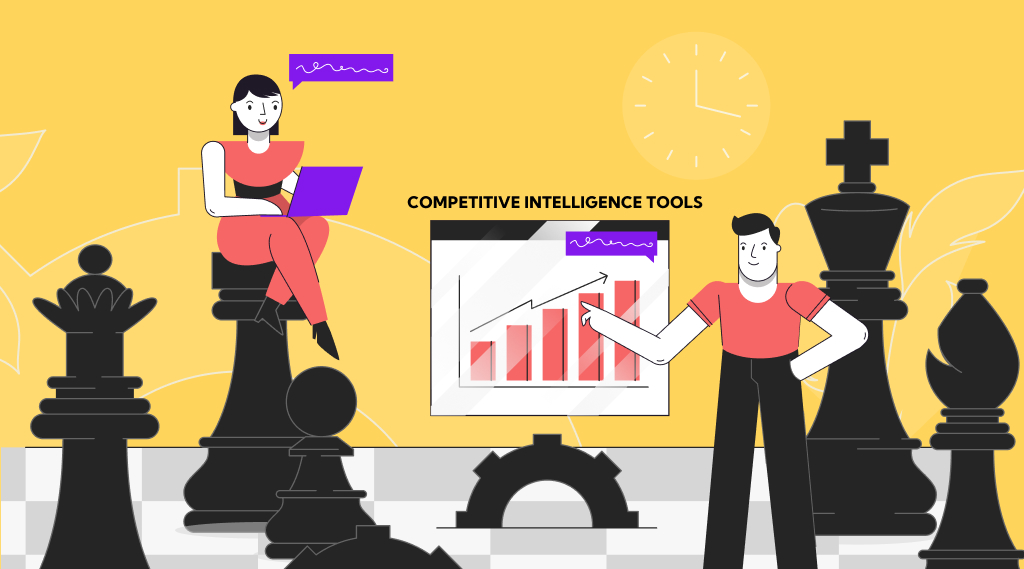Introduction
Competition is tough, and being ahead of the game is crucial. In this age of tough business competition, having the right tools and strategies can be a game-changer. That’s where competitive intelligence tools come in.
These tools are your secret to know what your competitors are up to, spot market trends, and make smart business decisions based on real data.
In this guide, we’ll introduce you to the top 15 competitive intelligence tools that are set to shine in 2024. These tools will help you improve your Google ranking and outperform your competition.
What is competitive intelligence?
Competitive intelligence, often abbreviated as CI, is the process of collecting, analyzing, and utilizing information about your competitors and the broader business environment to gain a strategic advantage. It involves gathering data on competitors’ actions, strengths, weaknesses, strategies, and market dynamics. The primary goal of competitive intelligence is to make well-informed decisions and formulate effective strategies that can help a business or organization excel in its market.
Competitive intelligence typically encompasses the following key activities:
1. Data collection: Competitive intelligence involves systematically gathering data from various sources, including competitor websites, industry reports, market research, social media, customer feedback, and public records. This data can provide a wide range of information, from product offerings to financial performance and customer sentiments.
2. Analysis: Once data is collected, it is meticulously analyzed to extract actionable insights. Analysts examine trends, patterns, and anomalies in the data to identify potential opportunities or threats. This step is critical for understanding your competitors’ strengths, weaknesses, and strategic moves.
3. Benchmarking: Benchmarking is a process of comparing your own performance, products, or services to your competitors. By benchmarking, you can determine where you excel and where improvements are needed. This can guide you in setting realistic goals for your business.
4. Market research: Competitive intelligence goes beyond analyzing competitors alone; it also includes extensive market research. This involves studying broader market trends, customer behavior, and industry developments.
5. Strategic planning: The ultimate goal of competitive intelligence is to inform strategic decision-making. Insights gathered from competitive intelligence activities are used to shape your business strategy. This involve adjusting your product offerings, marketing tactics, pricing strategies, or expansion plans based on what you’ve learned about your competitors and the market.
Competitive intelligence provides a comprehensive understanding of the competitive landscape and the broader business environment, enabling businesses to make data-driven, informed decisions, which can lead to increased competitiveness and long-term success.
What are the 7 P’s of competitive intelligence?
The 7 P’s of Competitive Intelligence outlines the essential components of an effective competitive intelligence process. These pillars help organizations systematically collect and utilize competitive intelligence to gain an advantage. The 7 P’s are:
1. Planning: In this initial phase, organizations set clear objectives for their competitive intelligence efforts. This involves defining what they want to achieve through intelligence gathering. The planning stage also includes determining the scope of the research, and outlining the key areas of focus.
2. Preparation: It is the process of assembling necessary resources to support competitive intelligence activities. This includes people, technology, and tools. Building a skilled team with expertise in data collection, analysis, and industry knowledge is essential. Utilizing technology and acquiring software that aids in data collection and analysis is part of the preparation process.
3. Collection: In this stage, organizations systematically gather data from different sources. These sources can include competitors, market research, industry reports, customer feedback, and publicly available information. Data collection involve monitoring competitors’ websites and social media, conducting surveys, or subscribing to industry publications.
4. Processing: The collected data is processed and then transformed into usable information. This involves organizing, categorizing, and validating the data. Data processing makes it easier to analyze and helps in deriving actionable insights.
5. Analysis: Analysis is a crucial pillar where experts interpret the processed data. Analysts look for trends, patterns, and anomalies that provide valuable insights. These insights may include identifying competitor strengths and weaknesses, emerging market opportunities, and potential threats.
6. Dissemination: Dissemination is about effectively communicating the intelligence findings to relevant stakeholders within the organization. This ensures that decision-makers and key personnel are informed. Methods of dissemination can include reports, presentations, and dashboards tailored to the needs of different teams and departments.
7. Utilization: The final pillar emphasizes the practical application of the gathered intelligence. Organizations must use the insights to shape business strategies, make well-informed decisions, and achieve competitive advantages. Utilization can involve adjustments to product offerings, pricing strategies, marketing campaigns, and more based on the intelligence gathered.
The 7 P’s of Competitive Intelligence provide a structured framework for organizations to establish and maintain a systematic approach to gathering, processing, and utilizing competitive intelligence effectively. This process empowers businesses to stay competitive, adapt to changing market conditions, and make informed strategic decisions.
15 Best competitive intelligence tools to use in 2024
Here are 15 examples of competitive intelligence tools used by businesses to gather and analyze data about their competitors and industry:
1. SEMrush:
Semrush provides comprehensive insights into competitors’ online presence, including keyword rankings, backlink profiles, and advertising strategies.
Features
- Backlink analysis
- Keyword tracking and analysis
- Detailed website traffic
- Social media tracking
- PPC and Advertising tracking and analysis
Pros
- Provides extensive insights into competitors’ organic and paid search strategies.
- Easy-to-use platform, suitable for beginners and experienced marketers.
- Helps in identifying high-performing keywords and gaps in competitors’ strategies.
- Offers detailed information on competitors’ backlink profiles for effective link building.
- Allows users to generate customized reports according to their specific needs and preferences.
Cons:
- Costly subscription and pricing plans may be expensive for small businesses or individuals with limited budgets.
- Requires time and effort to fully understand and utilize all features effectively.
- Historical data availability may be limited compared to other competitive intelligence tools.
- Some users report occasional inaccuracies in the data provided.
- Relies on data from third-party sources, which may not always be fully reliable or up-to-date.
Pricing:
- Pro: Starting at $119.95 per month
- Guru: Starting at $229.95 per month
- Business: Starting at $449.95 per month
These prices may vary based on additional features, add-ons, and payment options.
2. Ahrefs:
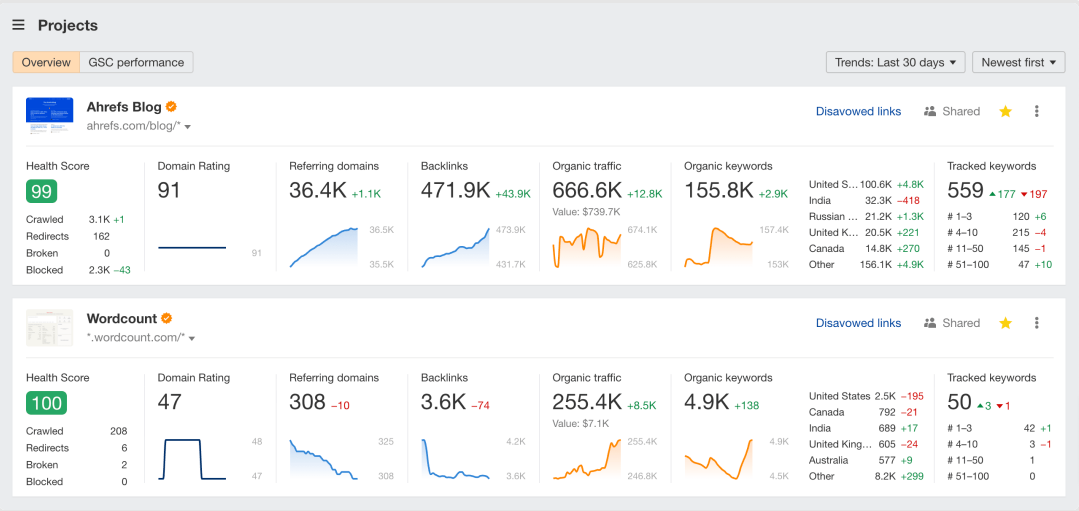
Ahrefs focuses on backlink analysis, keyword research, and SEO insights, helping businesses understand and improve their online visibility.
Features:
- Backlink Analysis
- Keyword Research
- Site Audit
- Rank Tracking
- Content Explorer
Pros
- Ahrefs provides detailed information about which websites are linking to yours and your competitors which helps in providing complete backlink data.
- It helps you find the best target keywords by showing their search volumes, difficulty levels, and potential traffic for better optimization.
- Ahrefs scans your website for technical issues and suggests improvements, ensuring that your site is optimized for search engines.
- You can track your website’s rankings for specific keywords over time and compare them with your competitors’, allowing you to see how well your SEO efforts are performing.
- Ahrefs helps in analyzing the performance of your content and your competitors’, by giving you valuable insights into what works and what doesn’t in your niche.
Cons
- Ahrefs can be expensive for smaller businesses and has limited features in its basic plan.
- While Ahrefs offers some social media metrics, it’s primarily focused on SEO, so its social media insights may not be as robust as dedicated social media analytics tools.
Pricing
- Lite Plan: $99 per month (limited features)
- Standard Plan: $179 per month (suitable for small businesses)
- Advanced Plan: $399 per month (ideal for growing businesses)
- Agency Plan: $999 per month (for agencies and large enterprises)
3. SpyFu:
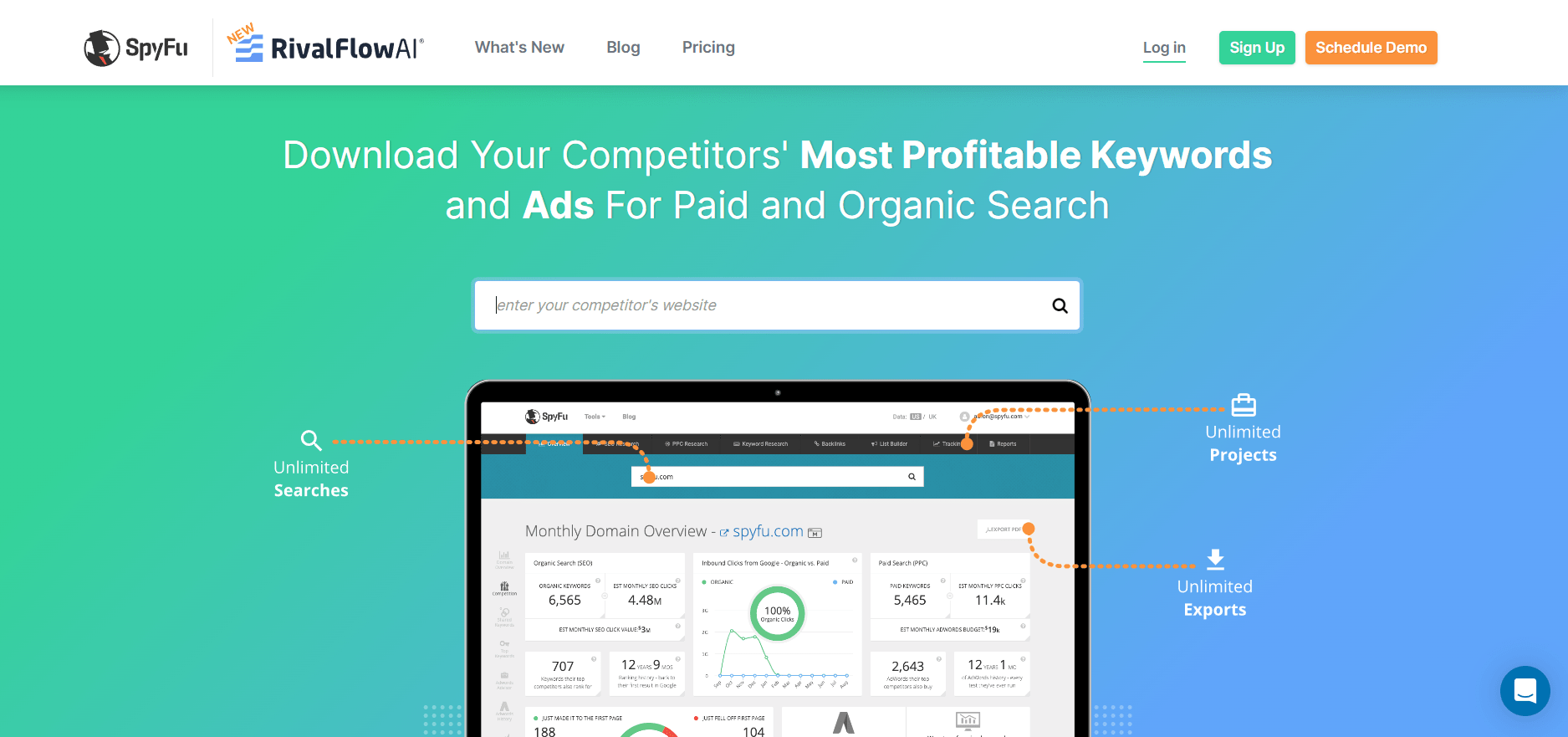
SpyFu offers competitive research on keywords, pay-per-click (PPC) advertising, and search engine rankings, helping users track and outperform competitors.
Features
- PPC Research
- Keyword Research
- Backlink Research
- Keyword Rank Tracking
- Competitive Analysis
Pros
- The tool has a user-friendly interface that makes it easy to navigate and access the information you need, even for users with limited technical expertise.
- It allows you to create custom reports and dashboards, enabling you to visualize data and share insights with team members or clients easily.
- By analyzing competitors’ ad spend and performance metrics, ithelps you optimize your own advertising budget to maximize ROI.
- SpyFu allows you to analyze your competitors’ PPC (Pay-Per-Click) campaigns, including ad copy, landing pages, and ad spend. This information can help you optimize your own PPC campaigns and improve ad performance.
Cons
- It provides a vast amount of data on competitors, keywords, and advertising campaigns. For some users, this abundance of information may be difficult to extract actionable insights without careful analysis and interpretation.
- SpyFu may not integrate well with all other marketing tools or platforms used by your business. This lack of integration could require manual data transfer.
Pricing
- Basic Plan: Starts at around $33 per month.
- Professional Plan: Starts at approximately $58 per month.
- Team Plan: Starts at about $199 per month.
4. Similarweb:
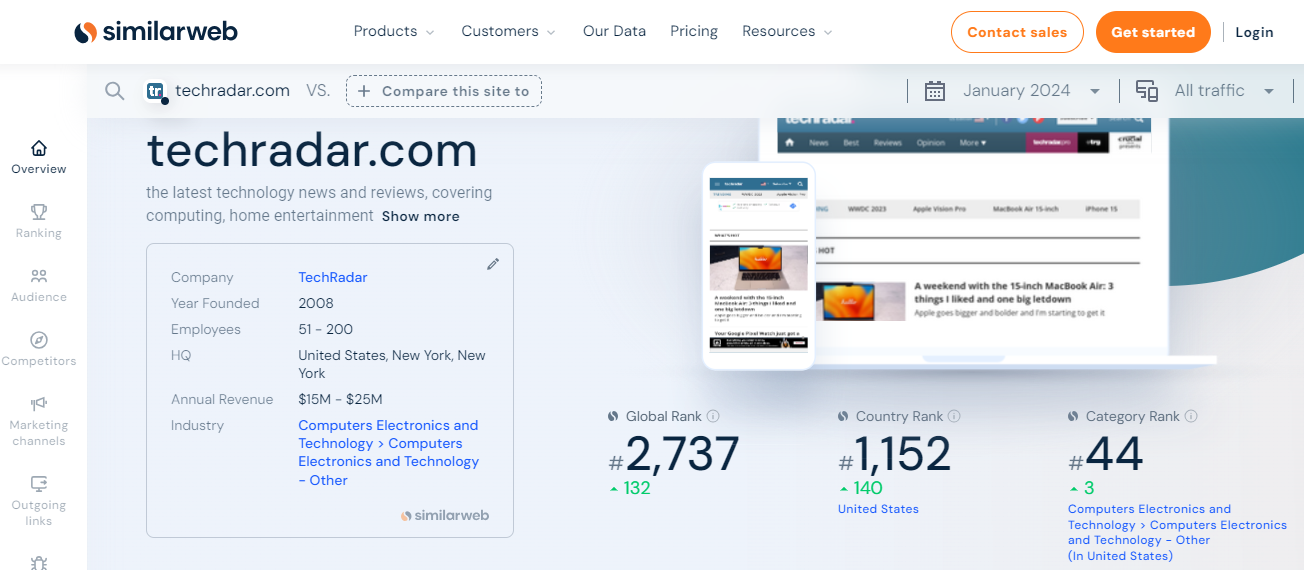
This tool provides web traffic and audience insights for websites, helping businesses understand their competitors’ online performance and user demographics.
Features
- Activity Dashboard.
- Benchmarking.
- Campaign Analytics.
- Campaign Management.
- Campaign Tracking.
Pros
- SimilarWeb offers insights into mobile app performance, including downloads, usage metrics, and user demographics. This is valuable for app developers and marketers who are looking to optimize their app’s performance.
- It allows you to create custom reports and dashboards to track specific metrics and KPIs relevant to your business goals.
- Detailed insights into website traffic, including total visits, unique visitors, pageviews, and bounce rates. This information helps you understand your own website’s performance and compare it to competitors.
- The tool provides demographic data about website visitors, including age, gender, location, interests, and device usage. Understanding your audience demographics helps you improve your marketing strategies.
Cons
- Data may not always be entirely accurate of actual website traffic.
- Some of the detailed data, such as audience demographics and traffic sources, may not be available for all websites, especially those with low traffic volumes. This limitation can make it challenging to get a comprehensive understanding of competitors’ strategies in certain cases.
Pricing
- Basic: Free or lower-cost entry-level plan with limited features.
- Pro: Starts at around $199 per month
5. Crayon:
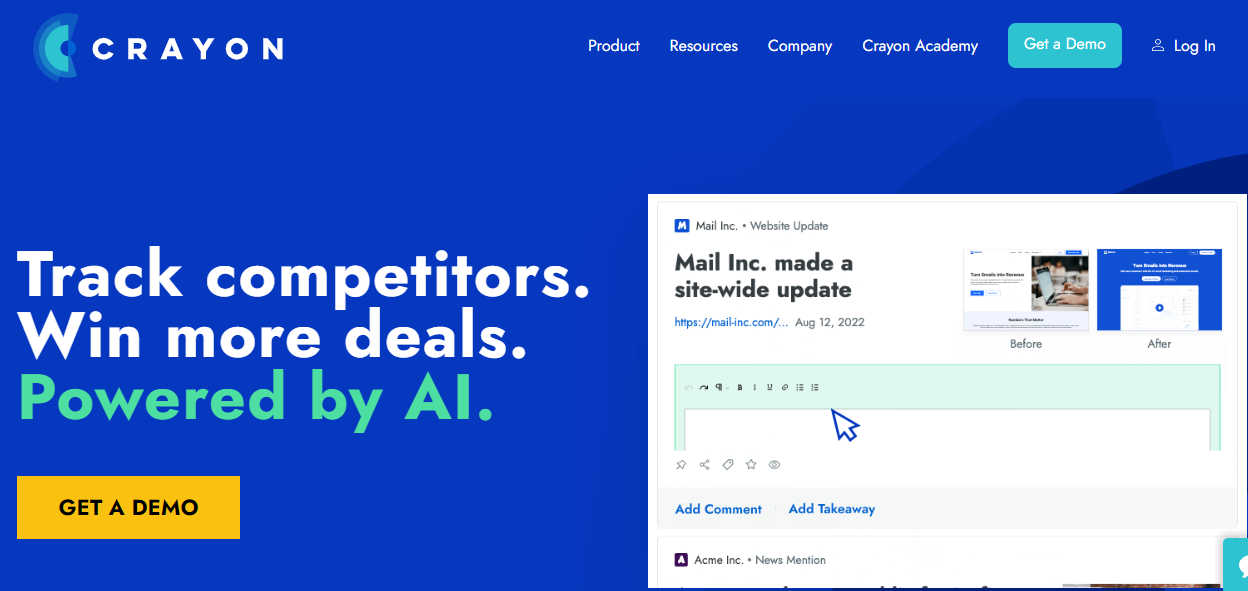
Crayon is a market and competitive intelligence platform that tracks changes on competitors’ websites, pricing strategies, and product launches.
Features
- Competitor Benchmarking
- Customizable Dashboards and Reports
- Integration with Third-Party Tools
Pros
- It provides continuous monitoring of competitors’ websites, digital channels, and product offerings, giving users a comprehensive view.
- Users receive real-time alerts and notifications whenever Crayon detects significant changes or updates on monitored competitors’ platforms. This allows for timely response and adaptation to market shifts.
- It generates detailed profiles for each competitor such as company overview, product features, pricing, messaging, and customer reviews. This helps users gain a deeper understanding of competitors’ strategies.
- Customizable dashboards and reporting tools help users to visualize and analyze competitive intelligence data in finding specific needs and objectives.
Cons
- Users might face privacy and compliance concerns when using Crayon to gather competitive intelligence, particularly regarding data protection regulations such as GDPR or CCPA. Ensuring compliance with relevant laws and regulations is essential to avoid legal risks.
Pricing
- Crayon pricing may vary from $14,600 to $27,100.
6. Brandwatch:
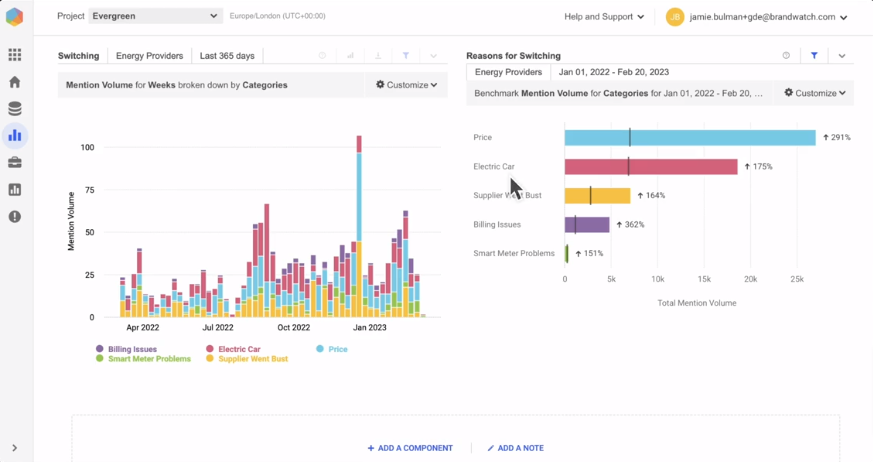
Brandwatch is a social media monitoring and analytics tool that helps businesses track and analyze mentions, sentiment, and trends related to their brand and competitors.
Features
- Real-time Social Listening
- Advanced Analytics
- Customizable Dashboards
- Competitive Intelligence
- AI-Powered Insights
Pros
- With Brandwatch, users can gain valuable competitive intelligence by tracking competitors’ online activities, analyzing their performance metrics, and identifying strengths and weaknesses.
- Brandwatch uses artificial intelligence and machine learning technologies to generate actionable insights from large volumes of data.
- It offers scalable solutions suitable for businesses of all sizes, from small startups to large enterprises. The platform also provides flexibility in terms of pricing plans, features, and customization options, ensuring that users can adapt the tool to their specific requirements and budgets.
- Brandwatch is known for its dedicated customer support team, providing assistance and guidance to users whenever needed. Their support team is extremely responsive and helpful.
Cons
- Brandwatch is expensive, especially for small businesses and individuals.
- The tool’s extensive features and functionalities can be overwhelming for new users. The learning c may require significant time and resources to fully grasp and utilize all aspects of the platform effectively.
Pricing
- Brandwatch offers custom pricing plans tailored to the specific needs and requirements of each client.
7.Buzzsumo:
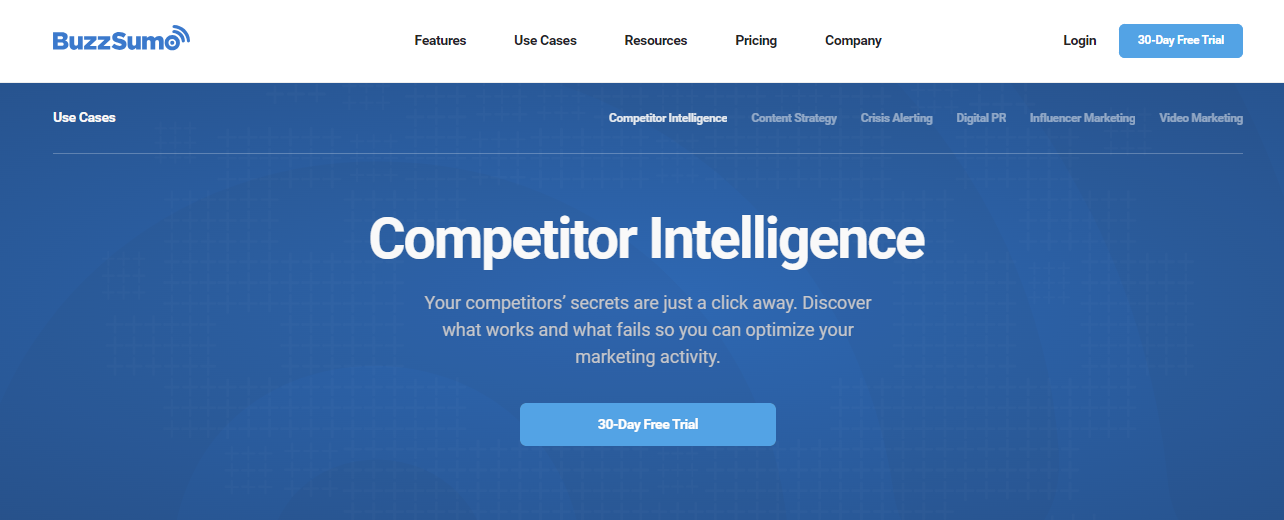
BuzzSumo offers content insights, helping users discover the most shared content in their industry, track competitor content, and identify influential social media users.
Features
- Content Discovery
- Influencer Identification
- Social Media Analytics
- Competitor Analysis.
- Content Insights
Pros
- BuzzSumo helps users discover popular and trending content in their niche, enabling them to stay updated with industry trends and generate ideas for their own content.
- The tool allows users to identify influential figures in their industry, facilitating influencer marketing campaigns and collaborations.
- It provides valuable insights into content performance on various social media platforms, helping users understand which content resonates with their audience.
Cons
- It may not cover all social media platforms comprehensively, potentially limiting insights for platforms not supported by the tool.
- Some users find BuzzSumo’s pricing to be relatively high, particularly for smaller businesses or individual users on a tight budget.
Pricing
- Pro Plan: Starting at around $99 per month
- Plus Plan: Priced at around $179 per month
- Large Plan: The Large Plan, priced at around $299 per month
8. Owler:
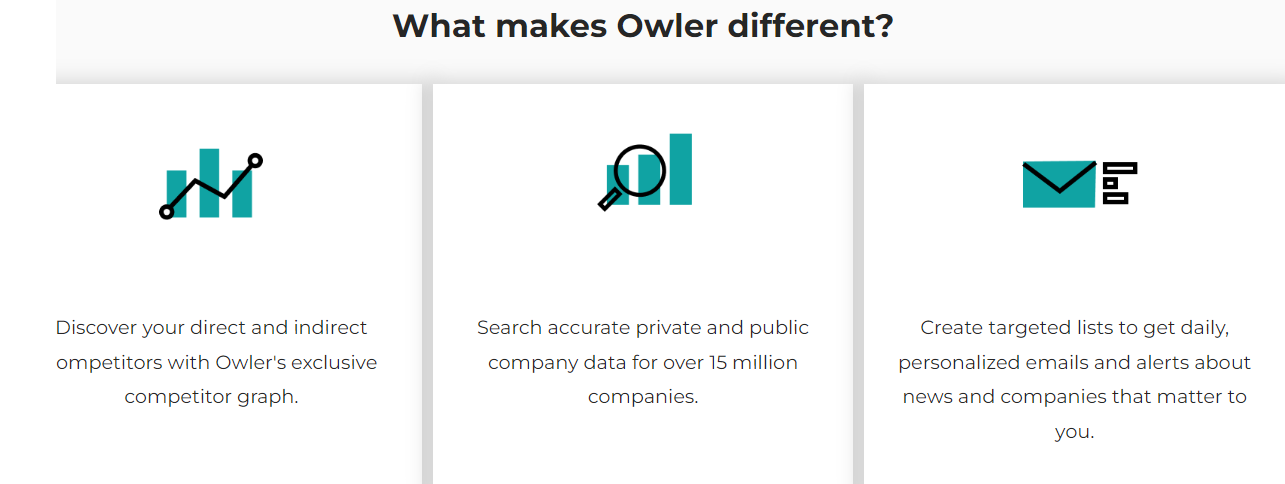
Owler is a competitive intelligence platform that provides company information, news updates, and competitive insights on businesses.
Features
- Competitor tracking
- Customizable insights
- Integration
Pros
- Owler’s community-driven platform allows users to contribute and verify information, ensuring the accuracy and reliability of company data and news updates.
- Owler provides extensive information on millions of companies worldwide, including key metrics such as revenue estimates, funding details, and leadership team information.
Cons
- The free version of Owler may have limited features and functionalities compared to premium plans.
- Owler’s reliance on user-contributed data and community verification may result in delays or inconsistencies in information updates, impacting the reliability of the platform.
Pricing
- Owler offers a free basic plan with limited features and paid plans starting at around $99 per month for more advanced features and functionality.
9. Serpstat:
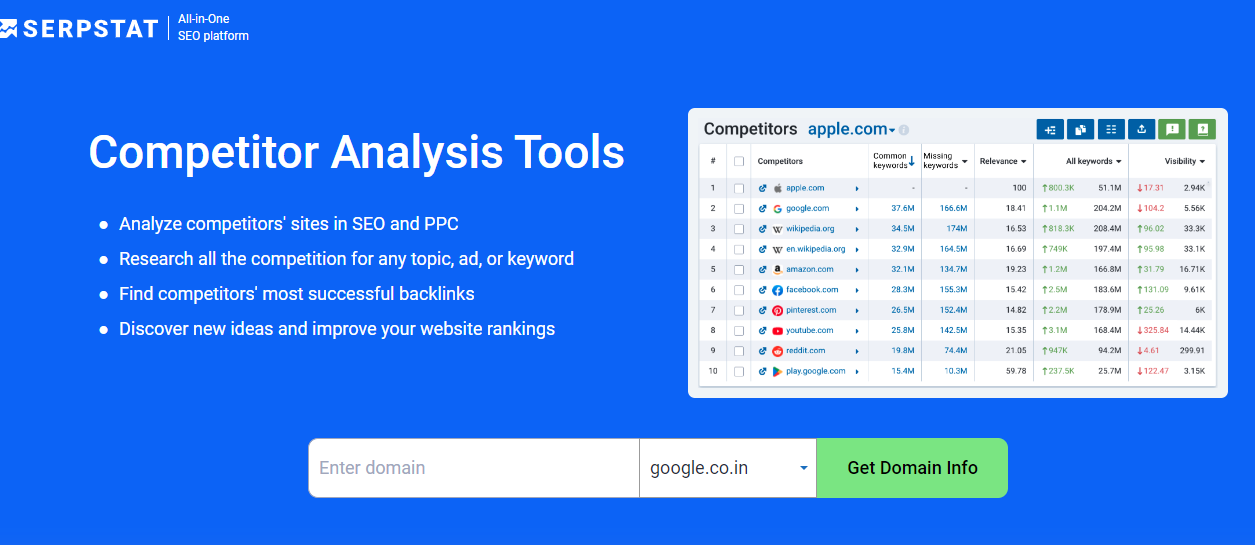
Serpstat offers comprehensive SEO and PPC analysis, keyword research, and competitive insights for optimizing online presence.
Features
- Content Marketing.
- PPC Research
- Site Analytics:
Pros
- The platform provides robust competitor analysis tools, allowing users to gain insights into competitors’ strategies, keywords, backlinks.
- It features an intuitive and easy-to-use interface, making it accessible for both beginners and experienced SEO professionals.
- Serpstat offers competitive pricing plans, making it accessible to businesses of all sizes and budgets. There’s also a free plan available with limited features for users to get started.
Cons
- Some users have reported issues with Serpstat’s customer support, including delays in response times and limited assistance with technical issues.
Pricing
- Lite Plan: Starting at around $69 per month
- Standard: Priced at around $149 per month
- Advanced: The Advanced plan starts at around $299 per month
10. Mozpro:
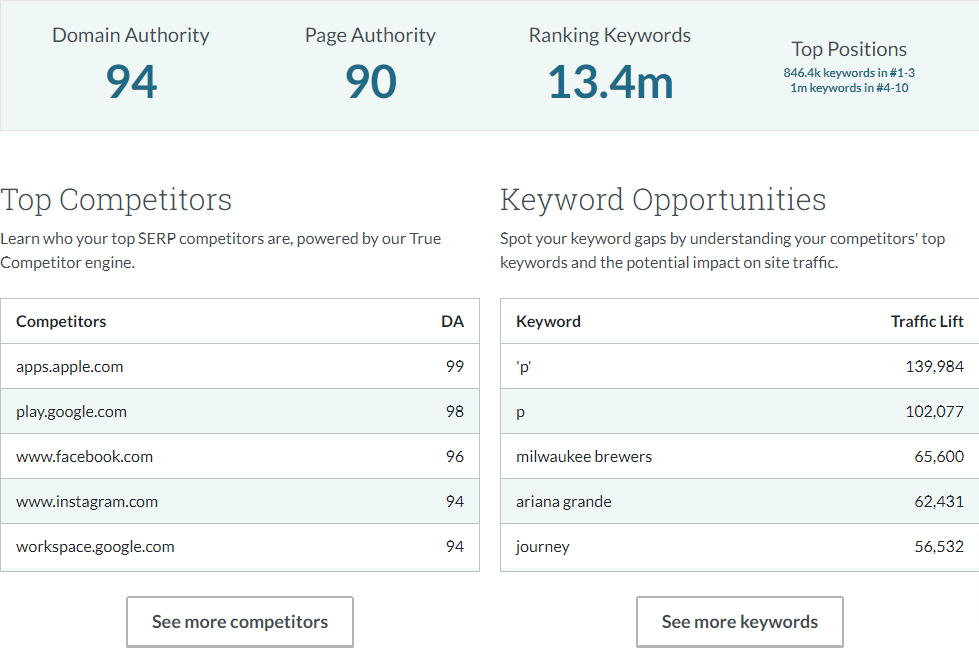
Moz Pro provides SEO tools, including keyword research, site audits, and backlink analysis, to improve search engine rankings and competitive positioning.
Features
- Link Explorer
- Keyword Explorer
- Rank Tracker.
Pros
- Moz Pro allows users to create customizable reports with branded templates, making it easy to share insights with clients, stakeholders, or team members.
- Features an easy-to-navigate user interface
- Offers excellent customer support, including access to a knowledge base, community forums, and responsive customer service representatives to assist users with any questions or issues they may encounter.
Cons
- Some users may find that Moz Pro’s features overlap with other SEO tools they are already using, leading to redundancy in their workflow.
- It may have limited integration capabilities with other SEO and digital marketing tools, requiring users to manually transfer data between platforms, which can be time-consuming.
Pricing
- Standard: The Standard plan starts at $99 per month
- Medium: The Medium plan starts at $179 per month
- Large: The Large plan starts at $249 per month
- Premium: The Premium plan starts at $599 per month
11. Crunchbase:
Crunchbase is a database of companies and startups, offering insights into funding, acquisitions, and partnerships within industries.
Features
- Search and Filtering
- Market Research
- API Access
Pros
- Entrepreneurs, startups, and business professionals can use Crunchbase to identify potential partners, customers, suppliers, or collaborators. By exploring investor profiles, company connections, and industry trends, users can expand their professional networks and forge valuable partnerships.
- Sales and marketing professionals can leverage Crunchbase to generate leads and identify prospects.
- It offers real-time updates and alerts on companies, investors, and industry trends. Users can stay informed about the latest developments, funding announcements, partnerships, and market shifts, enabling them to adapt quickly.
- Developers can integrate Crunchbase data into their own applications, platforms, or tools using the Crunchbase API.
Cons
- Crunchbase offers a free tier with basic features, access to more advanced functionality and detailed data often requires a paid subscription. This may limit access for individuals or organizations with budget constraints.
- Crunchbase offers various search and filtering options, users may find the platform’s customization options limited. Advanced users may desire more flexibility in creating custom queries and analyzing data.
Pricing
- Free: Basic access with limited features.
- Pro: Advanced features starting at around $29 to $49 per month billed annually.
- Enterprise: Customized plans for larger organizations with additional features and support.
12. Kompyte:
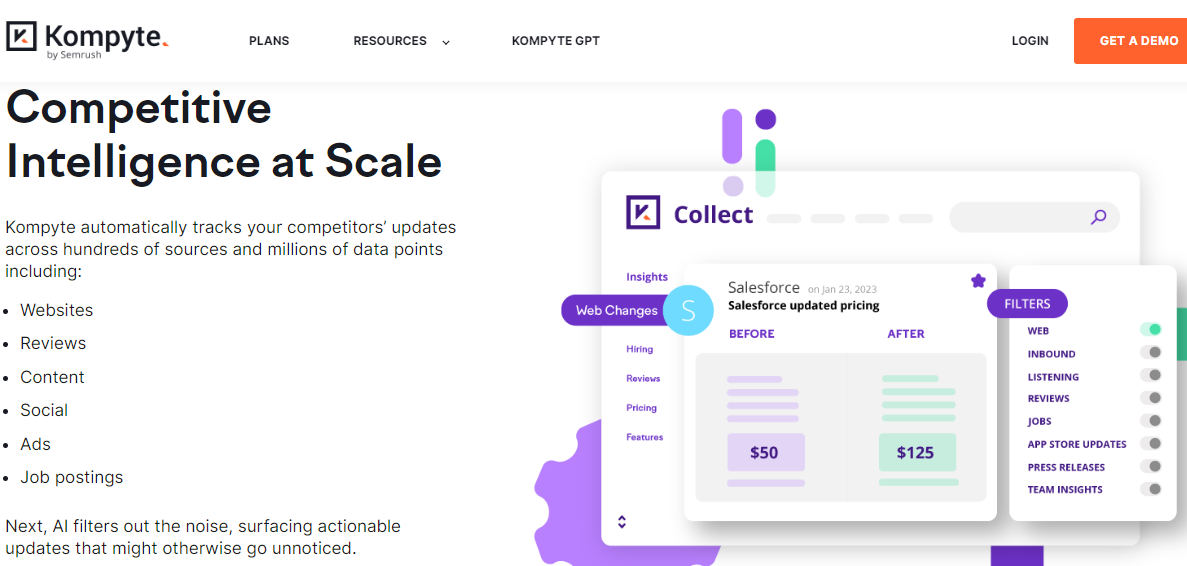
Kompyte is a competitor tracking tool that monitors changes to competitor websites and marketing strategies.
Features
- Competitor Tracking
- Automated Monitoring
- Competitor Benchmarking
- Content Analysis
Pros
- Real-time monitoring of competitor digital activities.
- Customizable alerts for significant competitor changes.
- Detailed analysis of competitor content strategies.
- Insights into competitor SEO and advertising tactics.
- Benchmarking against competitors’ performance metrics.
- Market intelligence reports for industry trends.
Cons
- Cost may be prohibitive for smaller businesses.
- Learning curve for mastering all features.
- Limited depth in certain industry-specific metrics.
- Overwhelming amount of data can be difficult to manage.
Pricing
- Basic: Limited features at a lower cost.
- Standard: More features at a mid-range price.
- Enterprise: Full suite of features with customized pricing.
13. Rivaliq IQ:
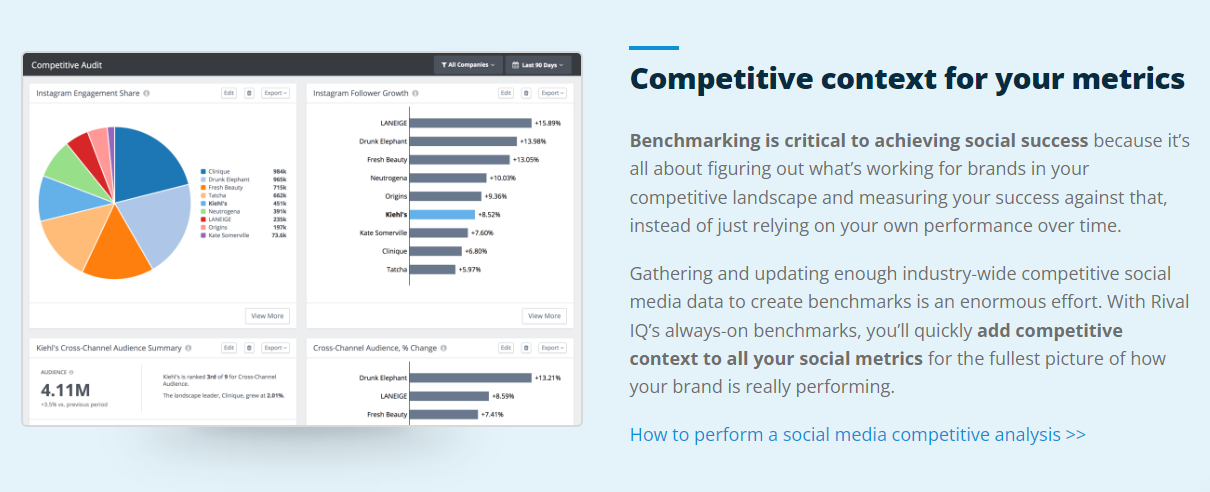
Rival IQ focuses on social media analytics and competitive benchmarking, helping businesses measure their performance against competitors.
Features
- Private Social Media Measurement. …
- Social Listening and Search. …
- Customizable Reporting.
Pros
- Benchmarking against industry peers for competitive advantage.
- Customizable reports and data visualization options.
- Integration with other marketing tools for streamlined workflows.
- Helps businesses stay informed and agile in competitive landscapes.
Cons
- Relies on competitor data availability and accuracy.
- Advanced features may require additional customization.
- Overwhelming amount of data can be challenging to manage.
- Continuous monitoring needed for ongoing insights.
Pricing
- Standard Plan: This plan typically starts at around $199 per month.
- Professional Plan: The Professional plan usually starts at around $349 per month.
14. Adbeat:
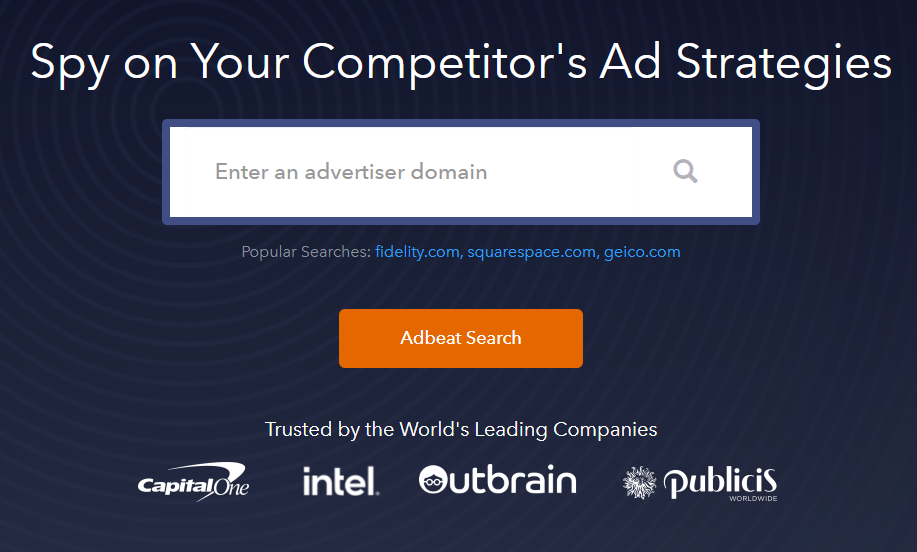
Adbeat is an ad intelligence platform that provides insights into competitors’ display advertising campaigns and strategies.
Features
- Ad Creatives and Copy
- Ad Performance Metrics
- Ad Placement Insights
Pros
- Users can analyze competitor ad copy and design elements for inspiration.
- Adbeat tracks historical data to identify trends in the market.
- Custom alerts notify users of competitor ad launches and changes.
- The platform enables monitoring of competitor ads based on specific keywords.
- Adbeat’s API access allows integration with other tools for advanced analysis.
- It helps businesses make data-driven decisions to optimize their own ad campaigns.
Cons
- Adbeat’s pricing may be prohibitive for small businesses.
- The platform’s interface might be overwhelming for new users.
- Certain niche industries may have limited competitor data available.
- Adbeat’s data may not always be fully accurate or up-to-date.
- It may not provide insights into emerging or niche advertising platforms.
Pricing
- Standard: $249/ month
- Advances: $399/ month
15. Prisync:
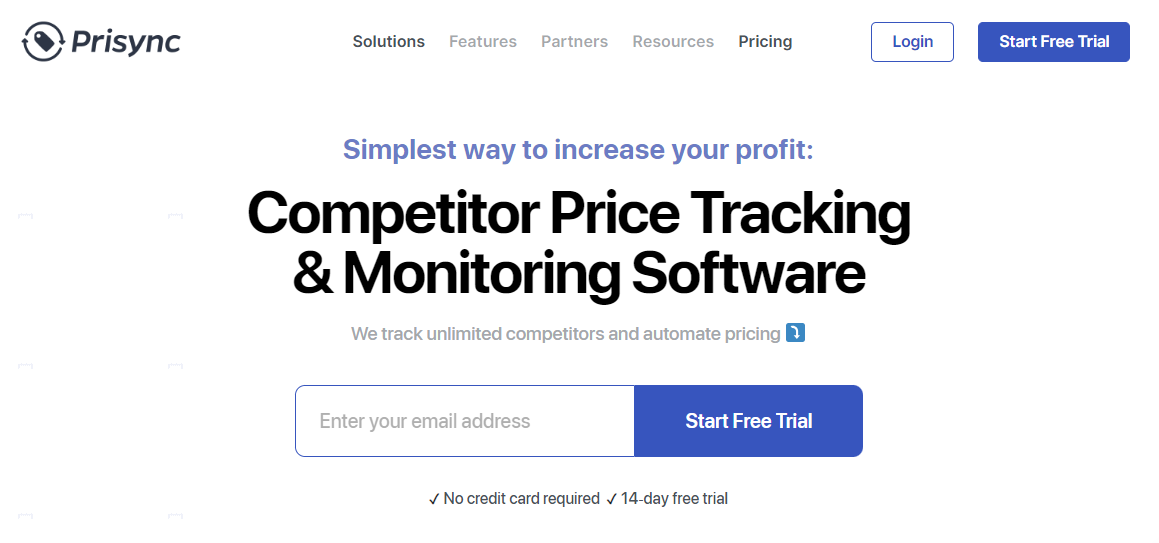
Prisync is a price tracking and monitoring tool that helps businesses optimize pricing strategies and track competitors’ pricing changes.
Features
- Price history
- Customizable reports
- Advanced Pricing Analytics
- Activity dashboard
Pros
- Prisync provides real-time competitor price tracking.
- It offers automated price change notifications.
- Prisync allows users to optimize pricing strategies for maximum competitiveness.
- The platform provides insights into competitor pricing trends.
- Users can monitor competitor stock availability and promotions.
- Prisync offers integrations with popular eCommerce platforms.
Cons
- The platform’s accuracy in tracking prices across all competitors and regions may vary.
- Integration issues with certain eCommerce platforms can occur.
- Prisync may not offer advanced features such as competitor product analysis.
- Users may experience occasional delays in data updates.
Pricing
- Professional: $99 per month
- Premium: $199 per month
- Platinum: $399 per month
These competitive intelligence tools offer a range of features and capabilities, allowing businesses to gather, analyze, and act on data that can improve their competitiveness in the market. The choice of tools depends on specific business needs and goals.
Conclusion
The competitive landscape in 2024 will continue to evolve rapidly, and businesses must adapt to stay competitive. The top 15 competitive intelligence tools mentioned here offer a diverse range of capabilities to help organizations gain a strategic edge. Whether it’s understanding competitors’ online presence, optimizing SEO strategies, tracking marketing efforts, or monitoring industry trends, these tools provide valuable insights that inform data-driven decision-making.
The dynamic nature of business environments will demand continuous monitoring and analysis. The right competitive intelligence tools can empower businesses to anticipate market shifts, identify opportunities, and respond effectively to changes in the competitive landscape. By leveraging these tools, organizations can position themselves for success in an ever-changing marketplace.
Start outsmarting your competition today! Get in touch with experts now to learn more about competitive intelligence tools and lead your industry in 2024!
